Bell Inn and Adjcent Schools
Summary of Deeds to the Bell Inn2
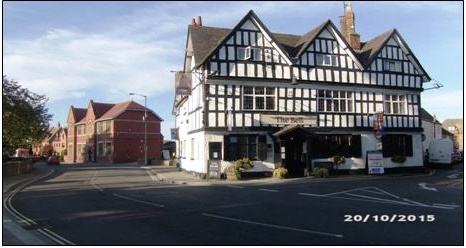
These papers relating to the Bell Inn were filed with the Abbey House School papers in the museum, as their history is interwoven with the site which later became the Abbey House School.
The archive starts in 1780 with a sale from the Earl of Essex and his heir George Capel (commonly called Viscount Malden; major landowners) to Kenelm Chandler (from a family of seventeenth-century butchers[3]) for £350.
All that Bowling Green and Great Garden whereon a new Room was built situate and lying near the Mills at the lower end of the Town of Tewkesbury. Together with the Tenement on the South East part of the Garden containing 1acre then late in the tenure of Nathaniel Chandler, deceased late father of Kenelm Chandler as tenant. All which Tenement, Garden etc were in the Parish of Tewkesbury and were part of the Messuages [a dwelling with buildings and land] and Premises comprised in the Sale [A, B, G and E].[4]
The property had a £2,000 annuity charge [pension] to the Countess Dowager of Essex and also a yearly rent charge of £20 to the poor of the parishes of Watford etc. but the Earl of Essex covenanted to indemnify [spare] Kenelm Chandler against these charges.
Analysis of Deeds to the Plot in Church Street Comprising the Bell Hotel and Grammar Schools
In the course of her voluntary work, cataloguing deeds in the town museum, Wendy discovered two sets of deeds which she felt should be studied as one plot of land – later subdivided – to aid historical understanding of the evolution of building within the town.| A | Bell Hotel |
| B | Malthouse/Homes |
| C | Abbey House School/Car Park |
| D | Boys’ Grammar School/Library/Abbey View School |
| E | Bowling Green/Housing |
| F | Abbey [Town] Mills |
| G | Bowling Green Garden/Car Park |
In 1807 Charlotte Chandler granted to Kenelm and his heirs forever. (Kenelm Chandler was store keeper of the ordnance department stationed in the city of Quebec in the province of Lower Canada. His will of 6 December 1803 bequeathed £50 to his sister, Sarah Chandler [whenever she should think proper to return to England] and also annuities of £40 to said sister Sarah and his sister Ann, wife of Richard Carloss respectively – the residue of his estate, he bequeathed to his wife Charlotte and son Kenelm Conor Chandler). Her share in the property now described as:
All that Messuage or Inn situate lying and being in Tewkesbury at the bottom of a street called Church Street formerly called by the name or sign of The Eight Bells but then by the name or sign of the Bell [A] together with the Stables and Buildings thereunto belonging. And also all that large enclosed garden called the Bowling Green Garden [G] together with the Bowling Green [E]. And also that piece or parcel of ground inclosed and used as a Coal Yard lying on the West side of the said Garden then in the occupation of John Brown as tenant [B].
In 1808 Ann, wife of Richard Carloss, died and was buried in Tewkesbury. In 1809 Kenelm Chandler, who was still in Quebec, sold the property to John Jenkins, maltster,5 for £3,000 but £800 of the money was to remain on mortgage to provide the £40 annuity to Sarah Chandler devised to her in her brother’s will.
In 1810 John Jenkins borrowed £1,000 from Henry William Harris and also had borrowed money from Lechmere’s Bank.6
In 1814 he purchased [C] namely:
All that Messuage formerly an Inn called The New Inn erected and built on a piece of ground theretofore used as a Rick Yard and whereupon a Barn called the Tythe Barn formerly stood in Tewkesbury – together with the Stable; Brew House; Buildings adjoining. He then created a garden for the house he would now occupy by walling in [D]7and part of the Bowling Green Garden [G].
By 1816 he was indebted to the bank for £1,400 and by 1823 with debts of £7,000 he was declared bankrupt and his estate (except for his house C & D) was put up for sale.
In 1823 Edward Causon (involved in the liquor trade) was the purchaser of the Bell Inn, stable and garden at £1,100 and also purchased the Bowling Green, summer house etc. for £390. A newspaper advertisement detailed:
Lot 2: All that well accustomed INN or PUBLIC HOUSE called THE BELL INN, situate near to the Abbey Church on the entrance from Gloucester and Cheltenham, with excellent stabling, Brew House, Cellaring, Large Garden and Piggery attached thereto, now in the occupation of Mr Barnwell Whitmore as Tenant. [A] Lot 3: All that very desirable and celebrated BOWLING GREEN adjoining to Lot 2 with a Summer House, Arched Cellar, and other conveniences forming a most desirable situation for building upon. [E]
A condition of the sale was that the £40 annuity to Sarah Chandler should be paid out of the Inn and that £800 for this purpose should be retained by Edward Causon. The remaining property was unsold but by 1824 the Commissioners for Bankruptcy re-advertised the estate for sale together with the house [C & D].
The Malt-House and Coal Yard [B] were offered for sale and purchased by Henry Kear Whithorn, a Tredington farmer, for £655; he shortly afterwards sold it to John Whitmore Isaac. This property was indemnified against the annuity to Sarah Chandler which was solely on the Bell Inn [A]. The Worcester Journal (8 July 1824) described it as:
Lot 2: All that very capital and strongly built double malt-house, capable of making six thousand bushels[8] in a season, with store-rooms and counting-house attached, lying near to the said mills.[B]. Lot 3: All that large and well established coal-yard, adjoining lot 2, and near to the River Avon.
The combined plot in about 2014 [J. Boskett]
- 1736: It was The Ten Bells
- 1798: Occupied by John Brown, formerly The Pied Bull then The Ring of Bells
- 1807: Charlotte Chandler gifted her share of The Eight Bells and then The Bell to her son
- 1835: The Ten Bells, often The Eight Bells, but then The Bell
Tewkesbury Town Museum’s Archive for the school papers mainly covers documents for the County Council Education Department to facilitate taking over the Abbey House School which was replaced by the Boys’ Grammar School in 1906.
The 1902 Education Act laid the basis for a national system of secondary education into which the higher grade elementary schools and the fee-paying secondary schools were integrated. Education control passed from locally elected Boards to the County Council, created after 1888. As a consequence of this schools were built in Chance Street for mixed gender elementary pupils, and in Church Street for male Grammar School pupils. To be accepted at the Grammar School a scholarship examination was taken usually at the age of 11 and those who passed were entitled to free education there. From 1899 to 1918 the school leaving age was 13 but Grammar School pupils were expected to stay on voluntarily until the age of 16.
The house [C, D and part G], was sold to Joseph Longmore for £840 and was described as:
Lot 5: All that excellent, most commodious, and newly erected freehold dwelling-house [C] situate at the lower end of the Church-Street, in Tewkesbury aforesaid, and near to the Abbey Church there; together with a good garden [D & G], stable, piggery, and other conveniences, late in the occupation of Mr. Jenkins.
By 1830 Edward Causon still owed the bank for the purchase money and he was declared bankrupt. The Bell Inn [A] was again put up for sale and was purchased for £1,400 by George Gardner, the son of William Gardner of the Chequers Inn, Church Street. He was to retain £800 of the purchase money for the £40 annuity to Sarah Chandler.
In 1833 Joseph Longmore purchased the Malthouse and Coal Yard [B] from John Whitmore Isaac for £625 – then described as:
The Malthouse Store Rooms Counting House and Parcel of Ground therein described together with all the appurtenances belonging and All that Parcel of Ground inclosed and used as a Coal Yard [B] situate on the Westward side of the Bowling Green theretofore in the occupation of John Brown since of John Jenkins.
In 1852 Joseph Longmore purchased the Bell Inn from George Gardner, and in 1853 he leased for 21 years at £70 a year:
the whole property above to James Agg Gardner of Cheltenham together with a Landing Place in the occupation of the Trustees of the Tewkesbury District of Roads.[9]
However, Joseph Longmore died in 1854 and, by his will, his whole estate was put up for sale10.
Lot 7: The Bell Inn and Bowling Green with the Gardens and Yards adjoining was put up at £600 and bought by Mr. Thomas for £920 (Mr. Thomas was a solicitor purchasing it for a client). [A and B]
Lot 8: The Abbey Malthouse started at £400 and was bought by Mr. Healing at £460. [B] Lot 9: The Dwelling House near the Abbey Church in the occupation of Mr. Priestlay was put up at £350 and sold to (Solicitor Joshua) Thomas for £460; purchased for the tenant, Mr. Priestlay.11 [C]
Joseph Priestlay in 1854Click Image
to Expand
At this auction in 1854 the property was Lot 9: the Dwelling House near The Abbey Church in the occupation of Mr. Priestlay was put at £350 and sold at £460 [C]. The Property was then described as:
All that Capital Dwelling House with the Brewhouse, Stable and other Outbuildings thereto adjoining and also the Court Yard the garden thereto being at the end of a certain street called the Church Street. The front of which Messuage extend 51 yards and a half and in depth 24 yards and the same are delineated on the Plan [below]
The Archive covers locations C and D, starting in 1798 with a feoffment[12] by Wakeman Long to John Brown of a “Piece of ground late used as a Rickyard whereon a Tythe Barn formerly stood” [C]. It was described as being:
South of a Messuage wherein John Brown dwelt formerly called the Pied Bull and then the Ring of Bells – next to a Rickyard whereon another Tythe Barn[13] also formerly stood [D] and having road leading by Tewkesbury [Abbey] Churchyard towards Gloucester on the East and a garden belonging to Mr Caleb Chandler on West.
In 1807 John Brown mortgaged “The Ground and a Messuage since erected and built by Brown” for £200 to Thomas Woollams and in 1808 raised a further (loan of) £200 upon the property.
In 1813 Brown then sold the property to a widow, Hannah Middleton, for £800, then described as:
A Messuage or Inn lately erected by John Brown commonly called “The New Inn” with Stable, Brew House, Buildings and Coal Yard [C].
The surrounding property then was The Bell Inn, garden and premises owned by John Jenkins and occupied by Richard King as Tenant [A and E]; ground whereon another Tythe Barn formerly stood [D] and the Turnpike Road.[14]
In 1814 Hannah Middleton (then wife of Richard Blakeway, innkeeper) sold the property to John Jenkins for £685 but Jenkins left a £485 mortgage (loan) with him.
We have already seen that John Jenkins had purchased the Bell Inn and Bowling Green and Bowling Green Garden in 1809, and he then converted The New Inn [C] and part of the Bowling Green Garden [G] into a dwelling house for himself. It seems this is when the property was walled in [C, D and part G]. To do all this he had borrowed money from Lechmere Bank – but by 1823 he was declared bankrupt with debts of £7,000 and his estate was sold in 1824.
The following is from the Worcester Journal (8 July 1824):
Lot 1: All that capital and most substantial stack of mills, called the Abbey or Town-Mills [F], situate on the junction of the River Avon with the Severn, with a pond of water15 seven miles long, forming more than a sufficient power to work four large water-wheels, which at present drive eight pair of stones, and are capable of grinding from five to six.quarters per hour, together with a piece of most valuable meadow land in the Severn-Ham, adjoining to the said mills, and containing about one acre and three quarters.
Lot 2: All that very capital and strongly built double malt-house, capable of making six thousand bushels in a season, with store-rooms and counting-house attached thereto, lying near to the said mills. [B]
Lot 3: All that large and well established coal-yard, adjoining lot 2, and near to the River Avon. [B]
Lot 4: All those four freehold cottages or tenements, with stable, fold-yard, cow-stalls, and piggery, situate on the Mill-Bank, in Tewkesbury, aforesaid, and near to all the preceding lots.
Lot 5: All that excellent, most commodious, and newly erected freehold dwelling-house, situate at the lower end of the Church-Street, and near to the Abbey Church there; together with a good garden, stable, piggery, and other conveniences, late in the occupation of Mr. Jenkins. [C]
This Dwelling House [vC] was Lot 5, purchased by Joseph Longmore of The Mythe at £840.
The House was obviously very desirable being tenanted by James Gale Senior esq (father of Lewis Goodin Senior who was bailiff with Joseph Longmore in 1827) and William Key Tunnicliffe, surgeon, and Rev. Robert Hepworth (Vicar of Tewkesbury). The will of Joseph Longmore stated that on his death all his real and personal estate should be sold and so when he died in 1854 the house was put up for auction.
![Plan of the 1902 Grammar School<br>[C, D and part G]](images/THS08621.jpg)
[C, D and part G]
In 1902 Annie Priestlay conveyed to Colchester Weymss and other Trustees for £1,330 (see Plans 5, 6 and 7):
the buildings known as Abbey House School [‘House’ shown in red]; the Land bought from Tredington forming part of the garden [shown in green] and the Stone Built Coach House on Gloucester Road formerly let [shown in blue].
The Education Authority planned to build a new Science and Art building in the grounds and the Science and Art building then used in the Oldbury would be sold to be part of this cost.16 Joseph Edward Priestlay was appointed Master of the new Tewkesbury Grammar School for seven years and there is an agreement that he lived rent free in the house but he did have to contribute towards water rates. A draft Scheme was drawn up giving details of “Head Master’s Salary – £200 plus capitation fees; the Curriculum of various subjects and hours per week to be taught; Fees; Free Scholarship Places and Expected Revenue”.
The new school, from 1906 to 1952 the Grammar School but today’s Abbey View School, was built on the garden and later the original house, the Headmaster’s residence, was demolished after 1952.
References
- The Abbey House School was a private school from 1853 [K. Ross, The Book of Tewkesbury, Baracuda 1989] to 1902 when it became the Boys’ Grammar School; before demolition it was the Headmaster’s House for the Grammar School which was opened in 1906. The Grammar School moved to Southwick Park in 1952 after which the building had various uses, e.g. the Library, Health Clinic etc., until in 2012 it became Abbey View School which is owned and operated by a company, ‘CCT Learning’. According to the Principal, “It is an alternative provision provider that delivers bespoke learning packages to students. This enables students to reach their next step in relation to education or training. This is achieved in a safe and supportive environment which allows students to reflect, reform and re-engage.”
- The deeds have been simplified for the modern reader by the Editor. The author acknowledges the Museum’s help.
- Woodard Database.
- C and D were always owned separately from the rest of the plot; both contained Tythe Barns as we learned in these deeds.
- From the Woodard Database we learn that John Jenkins was willing to risk loans in order to prosper. When he was bankrupt in 1824, he probably sold a “Villa at the Mythe” [Moores’ Notebooks] and it seemed to end his roles as a Churchwarden and Director of the Poor (although he preferred to pay a fine to be excused this unpopular duty). He died in 1861 aged 84, despite all, awarding himself the description of ‘Gentleman’. [Editor]
- Lechmere Bank eventually became the modern Lloyds Bank. Sir Edmund A.H. Lechmere was MP for Tewkesbury from 1866 to 1874.
- D always belonged to Tredington Parish and, although it was walled into the garden, rent was paid on it until 1906 when the County Council wished to own it legally and so purchased it. It was upon this garden that the new Grammar School [D] was built.
- A bushel was a traditional method of weighing corn, equivalent to 36 litres of liquid.
- In the Medieval Period, the road to Gloucester went along Mill Street and proceeded along the River Bank in what today are the Victoria Pleasure Gardens. The Landing Place was therefore probably located in this area. (See also 1836 Poor Rate Assessment ref. no 1060.) [Editor]
- Joseph Longmore: “By the age of thirty-three he had retired, having made a fortune in sugar. He bought The Mythe, one of the finest houses in the Borough and lived there for forty years, dying in 1854”. [B. Linnell, Tewkesbury Gossip (1978, Theot Press)]. Linnell is not quite correct as Longmore only purchased Mythe House in 1839 although he previously tenanted Mythe Villa. Mythe House was demolished in 1955.
- The Abbey School had been set up in various buildings in 1853 by Joseph Priestlay but it was amalgamated as a fee-paying grammar school in 1899 under his son, Joseph Edward Priestlay. The spelling was gradually changed to Priestley in the early 20th century.
- Feoffment refers to the transfer of ownership of land or property.
- A Tythe Barn was used for the storage of the tythe or a tax of a tenth of produce, payable to the church.
- This is now the A38 Tewkesbury to Gloucester Road. In about 1800 this road was improved by investors who charged tolls to pay for the building.
- Now known as the Mill Avon which was an artificial leat, dug at the behest of the monks in the 12th Century.
- The Oldbury building was demolished and replaced by Abbey Church of England Boys’ School until it was demolished for the construction of flats, now called Century Court.
to Expand
Joseph Priestlay had been an assistant master at Shuthonger School in Twyning in 1851. He married Annie Lacey in Manchester Cathedral on 25 August 1852 and set up a School in the House in Church Street in 1853, then purchased it in 1854. When he died in 1876, the property was left to his wife Annie but it continued as a school under his son, Joseph Edward. Joseph was a tenant paying £70 per annum for:-
“All that Dwelling House, Garden Ground commonly known as ‘Abbey House School’ situate in Church Street as now and for several years past in the occupation of the tenant - together with the Gymnasium …”
Conclusion
The plot started as one property owned by the Earl of Essex – except interestingly plots C & D which were Tithe Barns owned by others. Was one property, gradually subdivided with gardens, a relatively easy target for building? It is interesting how quickly wealth ebbed and flowed going from purchase to bankruptcy in a short time such as John Jenkins whose stay in the limelight lasted from 1814 to 1824, especially when it was based upon credit. However, Wendy wonders if his difficulties were compounded by the ending of the protection of corn prices at the end of the French Wars in 1815. We can see also how Joseph Longmore was using his liquid wealth [which we know from other sources had been repatriated from Jamaica] into buying investment property in Tewkesbury, his adopted Town from 1814 until his death in 1854 when his acquired wealth was dispersed [through lack of an heir]. The more deeds she studies makes Wendy keen to investigate
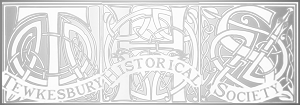
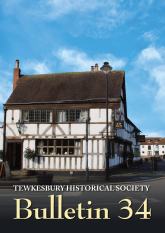


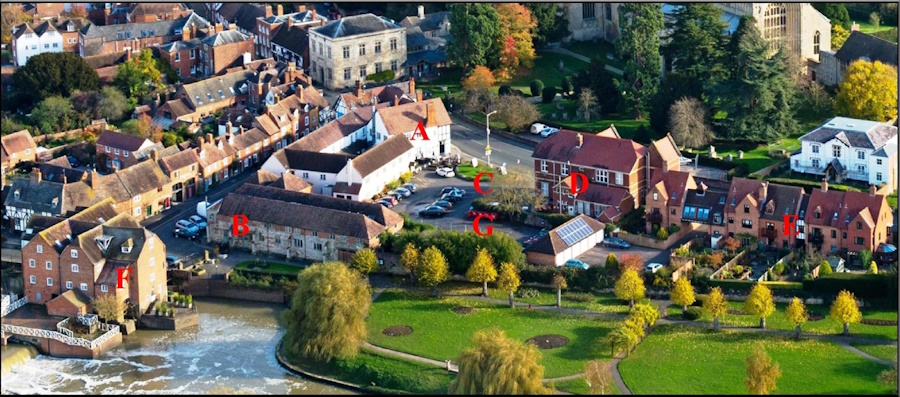
![Plan of Property [C & D] purchased by<br>Joseph Priestlay in 1854](/images/THS08618.jpg)
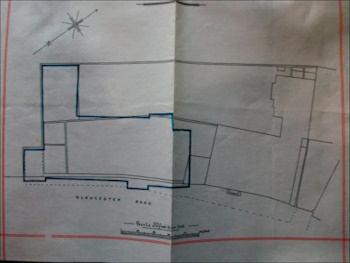
Comments